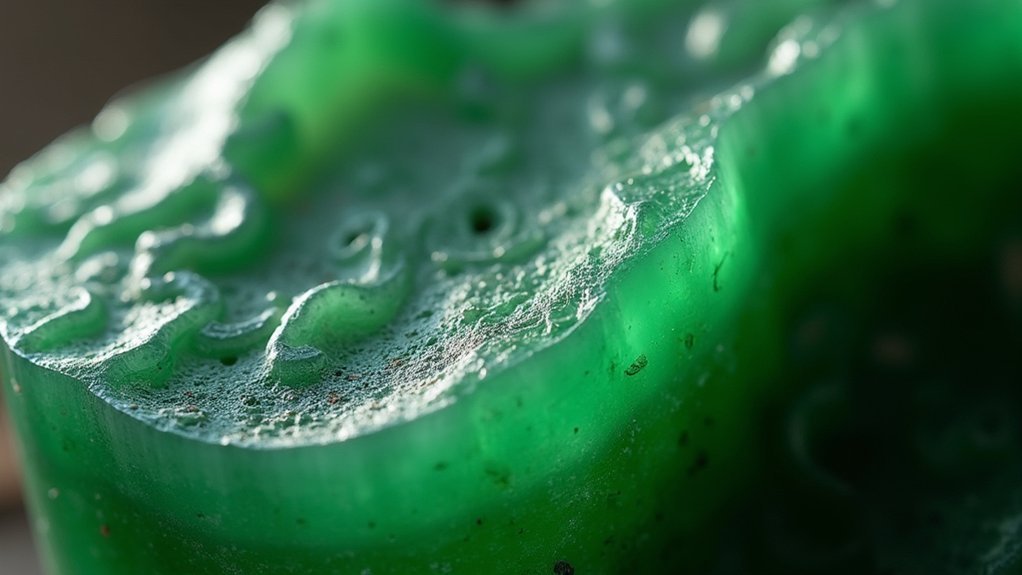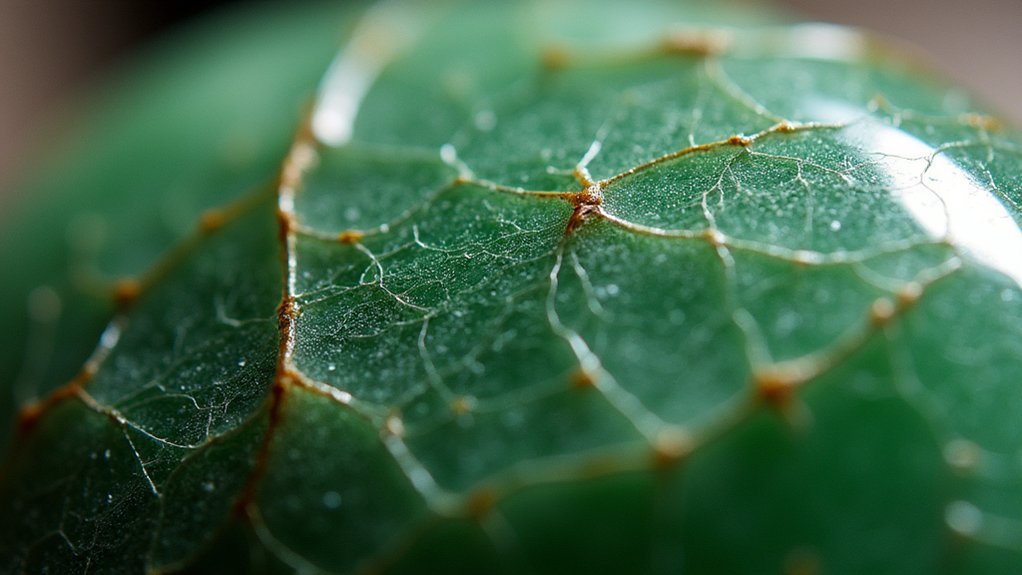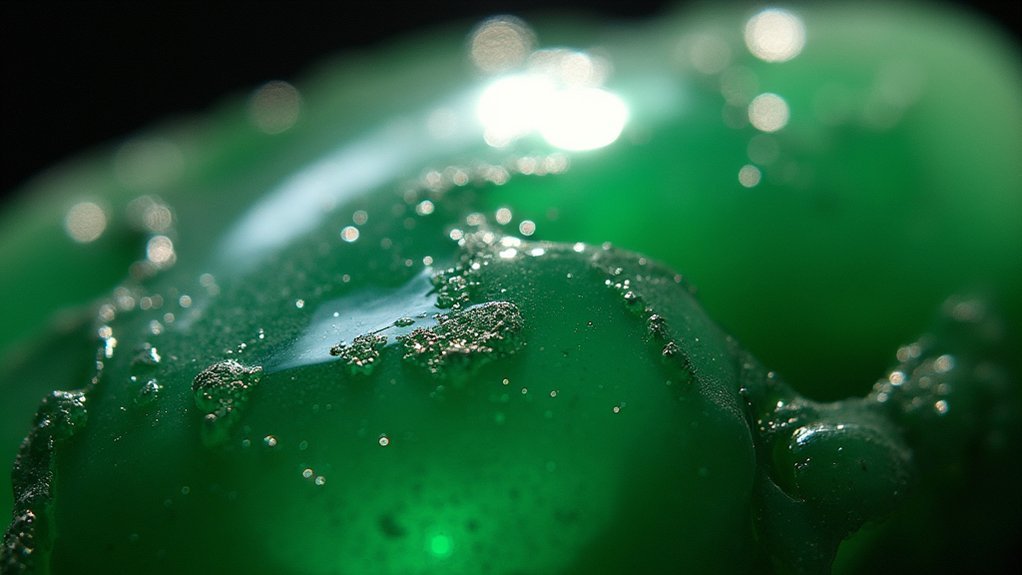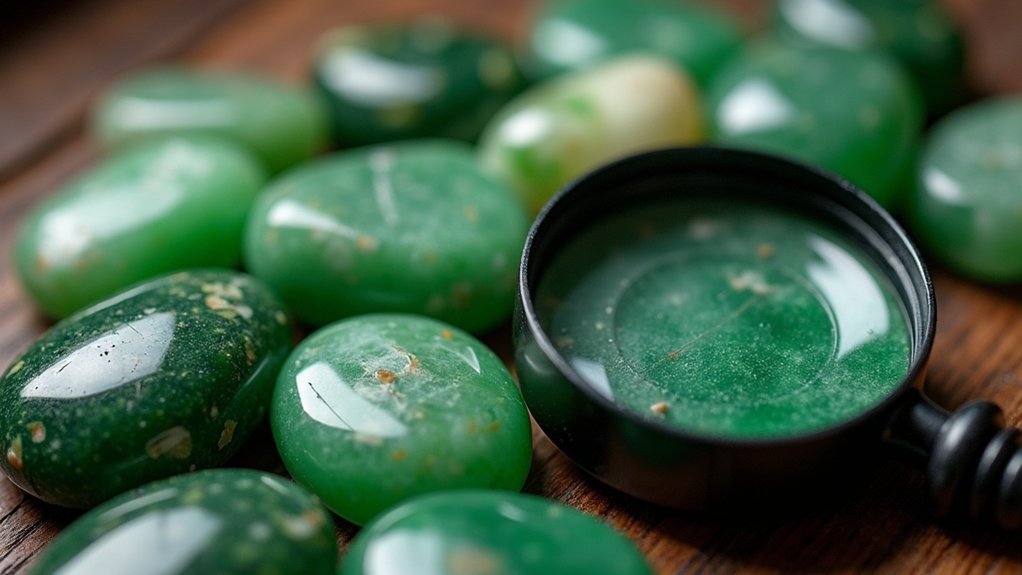You can identify polymer-impregnated jade by checking for Raman spectroscopy peaks near 3000 cm-1 and 1610 cm-1, examining surfaces for unnaturally glassy finishes, and looking for distinctive web-like patterns. Test with infrared spectroscopy, assess weight differences (treated jade weighs less), inspect for bubbles under magnification, and evaluate durability against acetone or detergents—authentic jade won’t deteriorate. These seven detection methods will help you distinguish genuine A-type jadeite from treated B-type specimens, though mastering these techniques requires understanding the science behind each approach.
Check for Raman Peaks Near 3000 Cm-1 and 1610 Cm-1

When examining jadeite jade for polymer impregnation, you’ll want to look for distinctive Raman peaks near 3000 cm-1 and 1610 cm-1 that signal the presence of resin or polymer chemicals from the treatment process.
These specific Raman peaks don’t appear in untreated A-type jadeite, which lacks any peaks above 1100 cm-1. This makes detection straightforward and reliable for distinguishing between treated ‘B’ jade and genuine ‘A’ jade.
Untreated A-type jadeite shows no Raman peaks above 1100 cm-1, making polymer-treated B jade detection straightforward and reliable.
You can use Raman spectroscopy, a non-destructive technique that provides clear identification without damaging your sample.
GemmoRaman software streamlines this process by automatically identifying these spectral features. Spotting these characteristic peaks is essential for both consumers and professionals who need to verify jade authenticity and determine proper market value.
Examine Surface for Glassy or Overly Smooth Finish
Surface inspection reveals telltale signs of polymer treatment through the characteristic glassy or unnaturally smooth finish that distinguishes treated jade from its natural counterpart.
You’ll notice that polymer-impregnated jadeite displays an overly reflective, mirror-like quality that contrasts sharply with untreated jade’s natural matte or waxy appearance.
When examining the piece, look for uniform surface sheen across the entire specimen.
Natural jade typically exhibits varying luster and texture, while treated pieces show consistent glossiness.
Pay close attention to areas around inclusions or imperfections where resin pooling creates uneven surfaces.
The high-gloss finish you’re observing indicates resin treatment, as authentic jadeite lacks this reflective quality.
Focus on texture variations—treated jade’s glassy or overly smooth finish will feel different from natural jade’s more authentic surface characteristics.
Look for Web-Like Surface Consistency Patterns

You’ll notice polymer-impregnated jadeite displays distinctive web-like patterns across its surface that aren’t present in natural jade.
These irregular networks create a characteristic texture that contrasts sharply with the smoother consistency of untreated specimens.
When examining potential purchases, run your fingers across the surface to detect these telltale web patterns that indicate polymer treatment.
Recognizing Web Patterns
How can you distinguish polymer-treated jadeite from natural specimens through visual inspection?
You’ll notice web-like surface consistency patterns that reveal resin treatment. These patterns appear as fine networks of lines spreading across the surface, resembling spider webs or clouds. They’re created when polymer resin fills surface cracks and imperfections during treatment.
Examine the jade closely under good lighting.
You’ll spot irregular, unnatural textures that don’t match genuine jade’s smooth consistency. The light reflection on these web patterns differs markedly from natural jade’s uniform surface.
Natural jadeite maintains consistent light reflection throughout, while treated specimens show varying reflective qualities where resin has been applied.
These visual differences make it relatively straightforward to identify polymer impregnation when you know what markers to observe.
Surface Texture Analysis
When examining jadeite for polymer treatment, focus on analyzing the surface texture through methodical inspection.
You’ll notice polymer impregnation creates an unnaturally slick, glossy feel compared to untreated jade’s subdued luster. Run your fingers across the surface – genuine jade feels smoother but not artificially slippery.
During surface texture analysis, look for resin-filled pores and fissures that create an overly uniform appearance. The polymer treatment eliminates natural jade’s subtle textural variations, replacing them with artificial consistency.
You’ll observe slight color saturation differences within web-like patterns where resin has penetrated.
Use proper lighting when conducting your examination, as polymer effects can be subtle. Natural jade maintains its authentic texture with gentle variations, while treated specimens display that characteristic unnaturally smooth, glossy finish that betrays chemical enhancement.
Test With Infrared Spectroscopy for Polymer Detection
You’ll find infrared spectroscopy offers the most reliable method for detecting polymer impregnation without damaging your jade specimen.
The technique works by identifying specific chemical fingerprints – particularly Raman peaks near 3000 cm-1 and 1610 cm-1 – that reveal resin presence in treated stones.
Since untreated A-type jadeite shows no peaks above 1100 cm-1, you can confidently distinguish between natural and polymer-enhanced jade through this non-destructive analysis.
How Infrared Works
Since infrared spectroscopy detects specific molecular vibrations within materials, it’s become the gold standard for identifying polymer impregnants in jade without causing any damage to your specimen. The technique works by measuring how infrared light interacts with molecular bonds in your jade sample.
When you examine the infrared spectrum, you’ll look for characteristic peaks that reveal polymer presence. Untreated A-type jadeite shows minimal absorption above 1100 cm-1, while treated B-type jade displays distinct polymer signatures.
| Jade Type | Key Peaks (cm-1) | Treatment Status |
|---|---|---|
| A-type | None above 1100 | Untreated/Natural |
| B-type | 3000, 1610 | Polymer Impregnated |
| Questionable | Variable patterns | Requires analysis |
You’ll find peaks near 3000 cm-1 and 1610 cm-1 particularly telling, as they indicate organic polymer impregnation definitively.
Polymer Peak Identification
Understanding polymer peak identification requires you to focus on specific wavelength ranges where organic compounds absorb infrared light most characteristically.
When examining polymer impregnated jade, you’ll need to identify key absorption peaks that reveal treatment presence. Look for distinctive peaks near 3000 cm-1 and 1610 cm-1 in your infrared spectrum readings. These wavelengths indicate polymer resins used during impregnation processes in B-type jadeite.
You’ll find that untreated A-type jadeite typically shows no Raman peaks above 1100 cm-1, making differentiation straightforward. These polymer signatures help you distinguish between treated and natural jade specimens reliably.
Non-Destructive Testing Benefits
Beyond identifying these polymer signatures, infrared spectroscopy offers significant advantages as a non-destructive testing method for jade authentication.
You’ll preserve your jade’s physical appearance and market value since this technique doesn’t alter the specimen in any way. Unlike destructive testing methods that might damage your precious stone, infrared spectroscopy examines the molecular composition without touching the surface.
The non-destructive testing benefits extend beyond preservation. You can confidently authenticate expensive jade pieces without risking their integrity.
This method provides precise, reliable results that visual inspections often miss, ensuring you’re making informed decisions about jade purchases or sales.
Whether you’re dealing with valuable antique pieces or contemporary jade jewelry, infrared spectroscopy delivers accurate authentication while maintaining your specimen’s pristine condition and full commercial value.
Assess Weight and Density Differences
When you’re examining jade for polymer impregnation, one of the most reliable detection methods involves comparing weight and density measurements.
You’ll want to perform a specific gravity test by weighing the jade in air, then submerging it in water to measure the difference. Untreated A-type jadeite typically maintains a density around 3.3 g/cm³, while polymer-impregnated B-type jade ranges from 2.9 to 3.3 g/cm³ due to lighter polymer content.
You can start by simply holding the piece—if it feels unusually light for its size, that’s your first red flag. The polymer treatment creates a noticeable weight reduction that you’ll detect through careful measurement and comparison with known authentic samples.
Inspect for Bubbles and Resin Inclusions Under Magnification

Close examination under magnification reveals telltale signs that distinguish polymer-impregnated jade from its natural counterpart.
Use a jeweler’s loupe or microscope to inspect the surface and edges carefully. You’ll notice bubbles or voids within the resin that indicate artificial treatment rather than natural structure. These irregularities and unnatural inclusions are clear red flags.
Pay attention to texture differences as well. Polymer-treated jade displays an overly smooth, glossy finish compared to authentic jadeite’s natural matte appearance.
Watch for consistent surface patterns or web-like formations, which signal resin application rather than natural jade formation.
The resin inclusions create an artificial uniformity that contrasts sharply with genuine jade’s organic variations and natural imperfections.
Evaluate Durability Against Detergents and Acetone
Since polymer-impregnated jade contains artificial resins that compromise its structural integrity, you can test its authenticity by observing how it reacts to common household chemicals.
‘B’ jade’s polymer treatments make it considerably more vulnerable to chemical damage than natural jade.
You can evaluate durability through these methods:
- Apply a small amount of acetone to an inconspicuous area using a cotton swab and observe for surface deterioration or color changes.
- Test with mild detergent solution on a hidden spot to check for polymer degradation or discoloration.
- Monitor the surface integrity after exposure, looking for softening, cloudiness, or structural weakening.
Natural jade remains unaffected by these substances, while treated ‘B’ jade shows visible deterioration, helping you distinguish between authentic and polymer-impregnated pieces.
Frequently Asked Questions
How to Tell if Jade Has Been Bleached?
You can identify bleached jade by looking for web-like surface patterns and unnatural floating colors. Use Raman spectroscopy to detect polymer peaks above 1100 cm-1, or infrared spectroscopy for confirmation.
How Can You Tell Jade From Resin?
You can distinguish jade from resin by checking thermal conductivity – jade feels cooler and conducts heat faster. Look for web-like surface patterns, floating colors, and request infrared spectroscopy testing for definitive identification.
How to Tell Real Vs Fake Jade?
You can identify real jade by testing its density, checking for natural color patterns, performing the scratch test, examining its temperature response, and using spectroscopy to detect polymer treatments or synthetic materials.
Does Fake Jade Glow?
You’ll find that fake jade typically doesn’t glow under UV light, unlike some natural stones. Polymer-impregnated jade usually stays dark, though it might show faint fluorescence from chemical residues used during treatment processes.
In Summary
You’ll protect yourself from fraudulent jade purchases by applying these seven detection methods. Don’t rely on visual inspection alone—you need scientific testing like Raman and infrared spectroscopy for definitive identification. Remember that polymer-treated jade won’t withstand chemical tests and displays telltale density differences. When you’re investing in jade, you can’t afford to skip these verification steps. Trust your instruments over appearances, and you’ll avoid costly mistakes in the jade market.





Leave a Reply